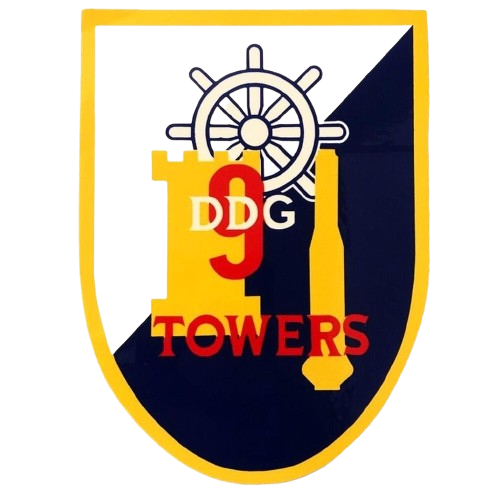Admiral John H. Towers
Admiral John H. Towers: The Struggle for Naval Air Supremacy

John Henry Towers graduated from the U.S. Naval Academy in 1906 and requested to be assigned to aviation duty. He was taught to fly by the first Naval Aviator, Lt. Theodore Ellyson, and qualified as Naval Aviator Number 3 in September 1911.
At the Navy’s first aviation camp in San Diego, Lt. Towers conducted the first testing associated with development of the original Curtiss seaplanes. On October 12, 1912, at Annapolis, Maryland, he established a world endurance record, when he remained airborne in the Curtiss A-1 for 6 hours 10 minutes 35 seconds.
In every chapter in the development of Naval Aviation, John Towers was there. He commanded the first aviation station, the Pensacola Base that became the flight training school for Navy pilots. He commanded the Navy’s aviation forces during the occupation of Vera Cruz in 1914. He had also developed the Naval Aviators badge, which has been worn so gallantly by so many. As senior aviator in the office of the Chief of Naval Operations during World War I, his astute planning and leadership guided U.S. Naval Air Forces.
In 1919, he was able to return to a plan he first conceived in 1914: to organize, train, and lead the first transatlantic air crossing. Although his own ship was forced down at sea, he accomplished the unique feat of sailing the aircraft several hundred miles to the Azores. One aircraft of the flight, the NC-4, completed the mission to Europe.
Between the wars, John Tower’s career paralleled the growing strength of Naval Aviation and he became the first Naval Aviator to achieve flag rank as Chief of the Bureau of Aeronautics in 1939. He organized the expansion of the Navy from 2,000 to nearly 10,000 aircraft and directed Naval Aviation in the opening period of World War II.
Insistence on leading a combat command resulted in his appointment as Commander Naval Air Forces Pacific Fleet where he directed the expansion of the carrier forces and led the air arm of the largest fleet ever assembled in history. His contributions were in large measure responsible for the victory in the Pacific. On December 1,1947, after 45 years of dedicated service to his country Admiral John H. Towers retired from active service.
Invested 1973 in the International Aerospace Hall of Fame
From “These We Honor,” The International Hall of Fame; The San Diego Aerospace Museum, San Diego, CA. 1984
From: DICTIONARY OF AMERICAN NAVAL FIGHTING SHIPS, Vol. VII, p. 249 -252.
John Henry Towers–born on 30 January 1885 at Pome, Ga.-graduated with the Naval Academy class of 1906 and was commissioned ensign in 1908, while serving in battleship Kentucky. He was later assigned to battleship Michigan before being sent to Hammondsport, N.Y., in 1911 for aviation duty.
Under the tutelage of Glenn Curtiss, Towers qualified as a pilot in August of that gear and went on to supervise the establishment of the Navy’s first aviation unit at Annapolis, Md., in the fall. He traveled to California where, in conjunction with the Curtiss Flying School at North Island in San Diego, he took part In developing and improving naval aircraft types.
After returning east thereafter, Towers was nearly killed in the summer of 1912. While he was flying as a passenger on 20 June, his plane was caught in a sudden downdraft and plummeted earthward. The pilot, Ens. W. D. Billingsley, was thrown from the aircraft and killed. Towers, too, was wrenched from his seat but managed to catch a wing strut and stayed with the plane until it crashed into the Chesapeake Bay. Interviewed by Glenn Curtiss soon thereafter, Towers recounted the circumstances of the tragedy; and the report and resultant recommendations eventually led to the design and adoption of safety belts and harnesses for pilots and their passengers.
On 5 March 1913, the Navy designated Towers Naval Aviator No. 3; and, in January 1914, he became the executive officer of the Naval Air Station at Pensacola, Fla. When Vera Cruz was occupied by the Navy and marines that spring, Towers commanded the aviation unit carried to that port in battleship Mississippi and cruiser Birmingham. In August 1914, one month into World War Z, Towers was ordered to London as assistant naval attache–a billet he filled until he returned to the United States in the autumn of 1916. Once back home, he supervised the establishment of the Naval Flying Corps-then in its infancy–and went on to become Assistant Director of Naval Aviation with the establishment of the Division of Aviation within the Navy Department.
In February 1919, Towers was placed in charge of the proposed transatlantic flight of the NC-flying boats end, while commanding NC-3, led the division from Trepassy Bay, Newfoundland. Though their ultimate destination was Lisbon, Portugal, NC-I and NC-PI encountered dense fog off the Azores and had to land to take bearings. Due to the heavy seas, neither could take off again; and the latter soon began shipping water. Towers and his crew managed to keep the flying boat afloat for 52 hours and eventually made Punts Delgada on Sao Miguel Island. NC-4 went on to complete the transatlantic crossing, arriving at Lisbon on 27 May. For his part in the operation, Towers received the Navy Cross.
Between the autumn of 1919 and the late winter of 1922 and 1923, Towers served at sea–as the executive officer of Aroostook and as the commanding officer of old destroyer Mugford, which had been redesignated an aircraft tender. Then, after a tour as executive officer at Pensacola Naval Air Station, he spent two and one-half years–from March of 1923 to September of 1925–as an assistant naval attaché, serving at the American embassies at London, Paris, Rome, the Hague, and Berlin. Returning to the United States in the autumn of 1925, he was assigned to the Bureau of Aeronautics and served as a member of the court of inquiry which investigated the loss of dirigible Shenandoah.
Towers next commanded Langley (CV-1) from January 1927 to August 1928. He received a commendation for “coolness and courage in the face of danger” when a gasoline line caught fire and burned on board the carrier in December 1927. Towers personally led the vigorous and successful attempt to suppress the flames kindled by the explosion and thus averted a catastrophe.
After shore duty in the Bureau of Aeronautics – successively serving as head of the plans division and later, as assistant bureau chief–Towers joined the staff of the Commander Aircraft, Battle Force, Rear Admiral Harry E. Yarnell, in June 1931. He was among the staff which planned a successful “attack” on Pearl Harbor during the Joint Army-Navy Exercise No. 4 in the Hawaiian Islands in February 1932–an operation which was to be duplicated on a larger scale by the Japanese in December 1941.
Between June of 1933 and June of 1939, Towers filled a variety of billets ashore and afloat: he completed the senior course at the Naval War College in 1934; commanded the Naval Air Station at San Diego; again served on the staff of ComAirBatFor; commanded Saratoga (CV-3); and became Assistant Chief of the Bureau of Aeronautics. On 1 June 1939, he was named Chief of the Bureau of Aeronautics with the accompanying rank of rear admiral.
As bureau chief, Towers organized the Navy’s aircraft procurement plans while war clouds gathered over the Far East and in the Atlantic. Under his leadership, the sir arm of the Navy grew from 2,000 planes in 1939 to 39,000 in 1942. He also instituted a rigorous pilot-training program and established a trained group of reserve officers for ground support duties. During Towers’ tenure, the number of men assigned to naval aviation activities reached a high point of some three quarters of a million.
Promoted to vice admiral on 6 October 1942, Towers became Commander, Air Force, Pacific Fleet. From this billet, he wisely and effectively supervised the development, organization, training, and supply of the Fleet’s growing aviation capability. For his sound judgment and keen resourcefulness, Towers received, successively, the Legion of Merit Medal and the Distinguished Service Medal.
In August 1945, Towers was given command of the 2d Carrier Task Force and Task Force 38, Pacific Fleet. On 7 November 1945, he broke his flag in New Jersey (BB-6) as Commander, 5th Fleet. On 1 February 1946, he hoisted his flag in Bennington (CV-20) as Commander in Chief, Pacific Fleet, a post he held until March of 1947.
After chairing the Navy’s General Board from March to December 1947, Towers retired on 1 December 1947. After retirement, Towers served as President of the Pacific War Memorial, a New York-based scientific foundation; as assistant to the President of Pan American World Airways; and as President of the Flight Safety Council. Admiral Towers died in St. Albans’ hospital, Jamaica, N.Y., on 30 April 1955.
————————————–
“One of the earliest Naval Aviators, he died at St. Albans Naval Hospital in Queens, New York, April 30, 1955 at the age of 70. He had lived at 161 East 79th Street in New York City and had told friends that he wanted any obituaries written about him to say, with no evasions, that he died of cancer.
“His career was a dogged battle to win acceptance for the airplane from a Navy that, during most of his years of service, was dominated by battleship Admirals. One of the most spectacular incidents of his career was a 1919 flight of three NC Navy Planes that took off from Newfoundland nd sought to cross the Atlantic. Then a Commander, he was forced to land his plane in rough seas and then taxied the plane 205 miles to the Azores. A secon crew also was forced down but the third, the NC-4, reached the Azores and then flew on to Portugal and England to become the first plane to cross the Atlantic. The expedition, for which he had been intrumental, proved a signal success for the Navy’s air-minded minority.”
He is buried in Section 30 of Arlington National Cemetery. His wife, Pierrette Anne Towers (1902-1990), is buried with him.
